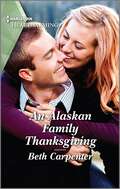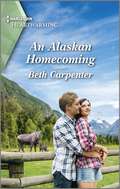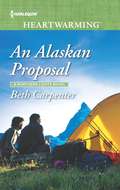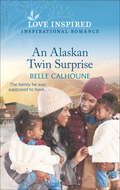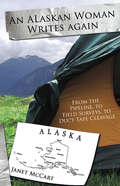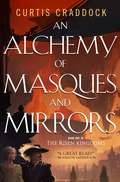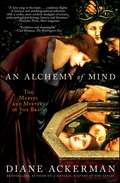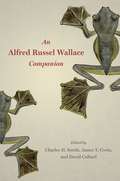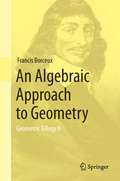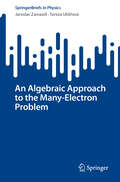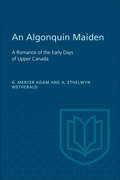- Table View
- List View
An Alaskan Christmas Promise: An Uplifting Inspirational Romance (K-9 Companions #11)
by Belle CalhouneA Christmas to cherish… And a secret to protect. This needs to be the best Christmas Kit O&’Malley has ever seen—because she may not be able to see another. Diagnosed with failing vision, it takes all her determination to stay focused on what makes her happy: her daughter, her service-puppy-in-training and the puppy&’s trainer, Leo Duggan. But they can&’t reach their Christmas joy together until Kit&’s secret comes to light… A K-9 COMPANIONS TALEFrom Love Inspired: Uplifting stories of faith, forgiveness and hope.K-9 Companions Book 1: Their Unbreakable Bond by Deb KastnerBook 2: Finding Her Way Back by Lisa CarterBook 3: The Veteran's Vow by Jill LynnBook 4: Her Easter Prayer by Lee Tobin McClainBook 5: Earning Her Trust by Brenda MintonBook 6: Guarding His Secret by Jill KemererBook 7: An Unlikely Alliance by Toni ShilohBook 8: The Cowboy's Journey Home by Linda GoodnightBook 9: A Reason to Stay by Deb KastnerBook 10: The Veteran's Holiday Home by Lee Tobin McClainBook 11: An Alaskan Christmas Promise by Belle CalhouneBook 12: A Steadfast Companion by Myra Johnson
An Alaskan Christmas: An Uplifting Inspirational Romance (Alaskan Grooms #6)
by Belle CalhouneA single mom starts over in Alaska and discovers love just in time for the holiday season in this inspirational romance—now a Harlequin movie, Love Alaska.After inheriting a gift shop in Love, Alaska, single mom Maggie Richards is ready for a new beginning—while her little boy is ready for a new daddy! But Maggie has no time for love—she wants to open the shop in time for Christmas, something she’ll do with help from childhood friend Finn O’Rourke. Finn’s on board to help Maggie—but not with the romance rumors that swirl around them like snow. Like Maggie, he’s hiding too many secrets to ever wed. So why do Maggie and her little boy make him dream of finding an unusual gift under the tree—a ready-made family?
An Alaskan Family Christmas: A Clean Romance (A Northern Lights Novel #7)
by Beth CarpenterA little mix-up…Could make her Christmas wonderful!Natalie Weiss is mortified. After mistaking handsome Tanner Rockford for his cousin, she’s followed him to rural Alaska. Now she’s stranded—until Tanner invites her to spend Christmas with his family in their rustic, cozy cabin. But in this idyllic winter wonderland, Natalie discovers the family she’s never had…and the love she never knew she needed. But what happens when they all discover why she’s really there?A Northern Lights NovelBook 1: The Alaskan CatchBook 2: A Gift for SantaBook 3: Alaskan HideawayBook 4: An Alaskan ProposalBook 5: Sweet Home AlaskaBook 6: Alaskan DreamsBook 7: An Alaskan Family Christmas
An Alaskan Family Found: A Clean and Uplifting Romance (A Northern Lights Novel #9)
by Beth CarpenterA temporary summer arrangement…Or their new forever? Alaskan peony farmer Caleb DeBoer can barely keep up with the weeds—let alone his willful teen daughter and being short-staffed at the start of wedding season. Luckily, sunny counselor Gen Rockford could really use a summer job and a place for her girls to live. Now what began as the perfect solution for Gen and Caleb is transforming into one unforgettable summer. But will one little secret ruin it all?A Northern Lights NovelBook 1: The Alaskan CatchBook 2: A Gift for SantaBook 3: Alaskan HideawayBook 4: An Alaskan ProposalBook 5: Sweet Home AlaskaBook 6: Alaskan DreamsBook 7: An Alaskan Family ChristmasBook 8: An Alaskan HomecomingBook 9: An Alaskan Family FoundBook 10: An Alaskan Family Thanksgiving
An Alaskan Family Thanksgiving: A Clean Romance (A Northern Lights Novel #10)
by Beth CarpenterHis task was simple…Until he met herAdam Lloyd has one job: revitalize the newly acquired failing seniors&’ apartment complex in picturesque Palmer, Alaska, by Thanksgiving. Falling for vivacious activities director Sunny Galloway and having his love of photography reawakened by her precocious daughter wasn&’t part of his plan. His failure would mean eviction for the tight-knit residents and unemployment for Sunny. But even if he succeeds, he can&’t stay in Palmer—can he?From Harlequin Heartwarming: Wholesome stories of love, compassion and belonging.A Northern Lights NovelBook 1: The Alaskan CatchBook 2: A Gift for SantaBook 3: Alaskan HideawayBook 4: An Alaskan ProposalBook 5: Sweet Home AlaskaBook 6: Alaskan DreamsBook 7: An Alaskan Family ChristmasBook 8: An Alaskan HomecomingBook 9: An Alaskan Family FoundBook 10: An Alaskan Family Thanksgiving
An Alaskan Homecoming: A Clean Romance (A Northern Lights Novel #8)
by Beth Carpenter&“Ever after&” wasn&’t the plan…Until now!Rowan O'Shea's intention was just to visit her family in the small Alaskan town she calls home. Now she's not sure she wants to leave, given the romantic mess she's left behind. A temporary fake marriage to gorgeous veterinarian Zack Vogel might be the perfect solution, if she can convince Zack. But Rowan's marriage of convenience has a seriously inconvenient snag—she's falling for her new fake husband! A Northern Lights NovelBook 1: The Alaskan CatchBook 2: A Gift for SantaBook 3: Alaskan HideawayBook 4: An Alaskan ProposalBook 5: Sweet Home AlaskaBook 6: Alaskan DreamsBook 7: An Alaskan Family ChristmasBook 8: An Alaskan Homecoming
An Alaskan Proposal: High Country Christmas The Marine's Return Her Cowboy Sheriff An Alaskan Proposal (A Northern Lights Novel #4)
by Beth CarpenterCan he teach her survival skills—without endangering his heart? When Sabrina Bell taps Leith Jordan for a crash course in conquering the great Alaskan outdoors, he figures he’s on safe ground. They’re polar opposites and his spectacular home state’s just a pit stop for the hotshot fashionista. So no one’s more surprised than Leith when he starts falling for her. Now he’s a man with a plan: get Sabrina to fall in love with Alaska…and, hopefully, with him.
An Alaskan Secret: An Uplifting Inspirational Romance (Home to Hearts Bay #1)
by Heidi McCahanComing home as a single dad… with a seven-year secret Back home in Hearts Bay, Alaska, Asher Hale&’s past has caught up with him. His son Cameron&’s new reading tutor, Tess Madden, is actually Cameron's mother—but she doesn't know it. Their teenage romance is one neither has forgotten, but Asher&’s secret lies between them. Now he will have to risk it all. Because telling the truth is the only path to a family reunion.From Love Inspired: Uplifting stories of faith, forgiveness and hope.Home to Hearts Bay Book 1: An Alaskan SecretBook 2: The Twins' Alaskan Adventure
An Alaskan Twin Surprise (Home To Owl Creek Ser. #2)
by Belle CalhouneDiscover this sweet romance set in a snow covered Alaskan town, part of the Home to Owl Creek series.His runaway bride is back… With twins!The last person Gabriel Lawson expects to find in town is Rachel Marshall—especially with twin toddlers in tow. Gabriel refuses to risk his heart again on the woman who left him at the altar years ago. But working to renovate her mother’s house means he must spend time with Rachel and her adorable twins…and soon he can’t help but wish they were his family. From Love Inspired: Uplifting stories of faith, forgiveness, and hope.Home to Owl Creek:Book 1: Her Secret Alaskan Family Book 2: An Alaskan Twin SurpriseBook 3: Alaskan Christmas Redemption
An Alaskan Wedding (A Wild River Novel)
by Jennifer SnowThey said goodbye years ago, but wedding bells just might remind these ex-lovers that their relationship was never really over…When they were high school sweethearts, Aurora Klein and Tyler Forrester imagined they would spend their entire lives together. Though Aurora’s dreams of going to college went beyond Wild River, Alaska, she would’ve chosen to compromise if it meant staying close to Tyler. Instead, he ended their relationship after graduation. With a broken heart, Aurora moved to California and never planned on looking back.And yet, six years later, Aurora finds herself back in Wild River to serve as maid of honor at her best friend’s wedding. There’s only one problem: Tyler is the best man. Aurora expects an awkward reunion, but she doesn’t count on rekindling the flame that still burns between them…or having to team up with him to search for the runaway bride!
An Alaskan Wedding (Alaskan Grooms #1)
by Belle CalhouneA Town Called Love Reporter Grace Corbett has the lead of a lifetime. The city girl moves to Love, Alaska, where the mayor's "Operation Love" is matching women from across the country with hunky Alaskan men. Grace pretends to be a woman looking for romance, and her act gets a lot easier when she starts to fall for rugged sheriff Boone Prescott. Grace vowed she'd never let herself love again, but in cold and beautiful Alaska, her heart is thawing for Boone. Still, to win the lawman she'll have to confess everything...and hope that Operation Love can manage one more happy ending.
An Alaskan Woman Writes Again: From the Pipeline, to Field Surveys, to Duct-Tape Cleavage
by Janet Mc CartAn Alaskan Woman Writes Again takes the reader along to experience the Trans-Alaska Pipeline, camping in the bush, encounters with bear and moose, and overcoming fear, through much laughter and some tears. These are stories of construction, geological tent camps, fishing, flying, golfing, and other personal stories of self-discovery are written through the eyes of an Alaskan woman.
An Album of Maya Architecture (Native American)
by Tatiana ProskouriakoffMagnificent guide presents 36 sites from Central America and southern Mexico as they appeared more than a thousand years ago: Temple of the Cross, Palenque; Acropolis and Maya sweat bath, Piedras Negras; Red House and north terrace at Chichén Itzá; more. Each illustration features text of archeological finds and line drawing of remains. 95 illustrations.
An Album of Memories: Personal Histories from the Greatest Generation
by Tom BrokawA seventeen-year-old who enlisted in the army in 1941 writes to describe the Bataan Death March. Other members of the greatest generation describe their war — in such historic episodes as Guadalcanal, the D-Day invasion, the Battle of the Bulge, and Midway — as well as their life on the home front. In this beautiful American family album of stories, reflections, memorabilia, and photographs, history comes alive and is preserved, in people’s own words and through photographs and time lines that commemorate important dates and events. Starting with the Depression and Pearl Harbor, on through the war in Europe and the Pacific, this unusual book preserves a people’s rich historical heritage and the legacy of the heroism of a nation.
An Alchemical Quest for Universal Knowledge: The ‘Christian Philosophy’ of Jan Baptist Van Helmont (1579-1644) (Universal Reform: Studies in Intellectual History, 1550-1700)
by Georgiana D. HedesanHistory of science credits the Flemish physician, alchemist and philosopher Jan Baptist Van Helmont (1579-1644) for his contributions to the development of chemistry and medicine. Yet, as this book makes clear, focussing on Van Helmont's impact on modern science does not do justice to the complexity of his thought or to his influence on successive generations of intellectuals like Robert Boyle or Gottfried Leibniz. Revealing Van Helmont as an original thinker who sought to produce a post-Scholastic synthesis of religion and natural philosophy, Georgiana Hedesan reconstructs his ambitious quest for universal knowledge as it emerges from the text of the Ortus medicinae (1648). Published after Van Helmont's death by his son, the work can best be understood as a compilation of finished and unfinished treatises, the historical product of a life unsettled by religious persecution and personal misfortune. The present book provides a coherent account of Van Helmont's philosophy by analysing its main tenets. Divided into two parts, the study opens with a background to Van Helmont's concept of an alchemical Christian philosophy, demonstrating that his outlook was deeply grounded in the tradition of medical alchemy as reformed by Theophrastus von Hohenheim, called Paracelsus (1493-1541). It then reconstitutes Van Helmont's biography, while giving a historical dimension to his intellectual output. The second part reconstructs Van Helmont's Christian philosophy, investigating his views on God, nature and man, as well as his applied philosophy. Hedesan also provides an account of the development of Van Helmont's thought throughout his life. The conclusion sums up Van Helmont's intellectual achievement and highlights avenues of future research.
An Alchemy of Masques and Mirrors: Book One in the Risen Kingdoms (The Risen Kingdoms #1)
by Curtis CraddockA delightful and engrossing fantasy debut featuring an intelligent heroine and her guardian, a royal musketeer.In a world of soaring continents and bottomless skies, where a burgeoning new science lifts skyships into the cloud-strewn heights, and ancient blood-borne sorceries cling to a fading glory, Princess Isabelle des Zephyrs is about to be married to a man she has barely heard of, the second son of a dying king in an empire collapsing into civil war.Born without the sorcery that is her birthright but with a perspicacious intellect, Isabelle believes her marriage will stave off disastrous conflict and bring her opportunity and influence. But the last two women betrothed to this prince were murdered, and a sorcerer-assassin is bent on making Isabelle the third. Aided and defended by her loyal musketeer, Jean-Claude, Isabelle plunges into a great maze of prophecy, intrigue, and betrayal, where everyone wears masks of glamour and lies. Step by dangerous step, she unravels the lies of her enemies and discovers a truth more perilous than any deception.At the Publisher's request, this title is being sold without Digital Rights Management Software (DRM) applied.
An Alchemy of Mind: The Marvel and Mystery of the Brain
by Diane AckermanThe most ambitious and enlightening work to date from the bestselling author of A Natural History of the Senses, An Alchemy of Mind combines an artist's eye with a scientist's erudition to illuminate, as never before, the magic and mysteries of the human mind.Long treasured by literary readers for her uncommon ability to bridge the gap between art and science, celebrated scholar-artist Diane Ackerman returns with the book she was born to write. Her dazzling new work, An Alchemy of Mind, offers an unprecedented exploration and celebration of the mental fantasia in which we spend our days -- and does for the human mind what the bestselling A Natural History of the Senses did for the physical senses.Bringing a valuable female perspective to the topic, Diane Ackerman discusses the science of the brain as only she can: with gorgeous, immediate language and imagery that paint an unusually lucid and vibrant picture for the reader. And in addition to explaining memory, thought, emotion, dreams, and language acquisition, she reports on the latest discoveries in neuroscience and addresses controversial subjects like the effects of trauma and male versus female brains. In prose that is not simply accessible but also beautiful and electric, Ackerman distills the hard, objective truths of science in order to yield vivid, heavily anecdotal explanations about a range of existential questions regarding consciousness, human thought, memory, and the nature of identity.
An Ale of Two Cities (A Literary Pub Mystery #2)
by Sarah FoxIn this intoxicating mystery by USA Today bestselling author Sarah Fox, a winter carnival becomes a recipe for disaster when a Shady Creek celebrity gets iced. The Winter Carnival always brings holiday cheer, Christmas joy—and tourists with cash—to picturesque Shady Creek, Vermont. At the center of the glittering decorations and twinkling lights is booklover and pub owner Sadie Coleman, creating original cocktails, hosting a literary trivia evening, and cheering on her loyal employee Melanie “Mel” Costas as she competes in the ice carving competition. But holiday cheer can’t compete with former resident and renowned chef Freddy Mancini, who arrives with his nose in the air, showing off his ice-sculpting skills like a modern-day Michelangelo. During the artists’ break in the night-long contest, Mel’s tools disappear . . . and Freddy is found dead with her missing pick in his chest. Although the police turn their attention to Mel, it seems everyone in town had a grudge against Freddy, including his assistant, his mentor, his former flame, and even his half-brother. Faster than she can fling a Huckleberry Gin, Sadie finds herself racing to make sure the police don’t arrest the wrong suspect—all while sharing a flirtation with local brewery owner Grayson Blake. Their chemistry leads to a heated rivalry at the hockey rink—and to the hot pursuit of a killer.
An Alex Cross Omnibus: Cat And Mouse and Pop Goes The Weasel
by James PattersonTwo classic Alex Cross novels in one fantastic package. In CAT AND MOUSE, Alex Cross is called to Union Station train terminal a man is on the loose, firing at random into the swarming crowds of travellers. Psychopath Gary Soneji seems determined to go down in a blaze of glory, and he wants Alex Cross to be there. Will this be the final showdown? In POP GOES THE WEASEL, the mounting numbers of bodies threatens to spiral out of control with the murder of yet another Jane Doe. Alex Cross must work alone to find a dangerous and clever killer with the perfect cover, someone beyond suspicion and almost impossible to track down...
An Alex Cross Omnibus: Roses Are Red and Violets Are Blue
by James PattersonA great value omnibus edition comprising two Alex Cross novels - the bestselling US detective series of the last decade. ROSES ARE RED: A series of bank robberies ends in murder and Alex Cross must pit his wits against the bizarre and sadistic mastermind behind the crime. Torn between dedication to his job and commitment to his family, Cross cannot ignore the case, despite the risks he know will come with hunting down a killer - and the heartbreaking cost. In Roses Are Red James Patterson takes us deep inside the crazy world of the psychopath - where mind games lead to violence and the slightest mistake will be punished with death. VIOLETS ARE BLUE: The Mastermind is back - and he's hot on Alex Cross's trail. His threats make Alex angry - and deeply concerned about his family's safety. Meanwhile, Alex Cross is involved in his most bizarre investigation yet. Two San Francisco joggers are found dead - bitten and hung by their feet to drain the blood. Is this the work of a cult or modern-day vampires? Alex teams up with Jamilla Hughes, a savvy female detective, and the FBI's Kyle Craig. But Alex Cross has never been closer to defeat, or in greater danger. In a shocking conclusion, he must survive a deadly confrontation - and will learn at last the terrible secret of the Mastermind.
An Alfred Russel Wallace Companion
by Charles H. SmithAlthough Alfred Russel Wallace (1823–1913) was one of the most famous scientists in the world at the time of his death at the age of ninety, today he is known to many as a kind of “almost-Darwin,” a secondary figure relegated to the footnotes of Darwin’s prodigious insights. But this diminution could hardly be less justified. Research into the life of this brilliant naturalist and social critic continues to produce new insights into his significance to history and his role in helping to shape modern thought. Wallace declared his eight years of exploration in southeast Asia to be “the central and controlling incident” of his life. As 2019 marks one hundred and fifty years since the publication of The Malay Archipelago, Wallace’s canonical work chronicling his epic voyage, this collaborative book gathers an interdisciplinary array of writers to celebrate Wallace’s remarkable life and diverse scholarly accomplishments. Wallace left school at the age of fourteen and was largely self-taught, a voracious curiosity and appetite for learning sustaining him throughout his long life. After years as a surveyor and builder, in 1848 he left Britain to become a professional natural history collector in the Amazon, where he spent four years. Then, in 1854, he departed for the Malay Archipelago. It was on this voyage that he constructed a theory of natural selection similar to the one Charles Darwin was developing, and the two copublished papers on the subject in 1858, some sixteen months before the release of Darwin’s On the Origin of Species. But as the contributors to the Companion show, this much-discussed parallel evolution in thought was only one epoch in an extraordinary intellectual life. When Wallace returned to Britain in 1862, he commenced a career of writing on a huge range of subjects extending from evolutionary studies and biogeography to spiritualism and socialism. An Alfred Russel Wallace Companion provides something of a necessary reexamination of the full breadth of Wallace’s thought—an attempt to describe not only the history and present state of our understanding of his work, but also its implications for the future.
An Algebraic Approach to Geometry: Geometric Trilogy II
by Francis BorceuxThis is a unified treatment of the various algebraic approaches to geometric spaces. The study of algebraic curves in the complex projective plane is the natural link between linear geometry at an undergraduate level and algebraic geometry at a graduate level, and it is also an important topic in geometric applications, such as cryptography. 380 years ago, the work of Fermat and Descartes led us to study geometric problems using coordinates and equations. Today, this is the most popular way of handling geometrical problems. Linear algebra provides an efficient tool for studying all the first degree (lines, planes) and second degree (ellipses, hyperboloids) geometric figures, in the affine, the Euclidean, the Hermitian and the projective contexts. But recent applications of mathematics, like cryptography, need these notions not only in real or complex cases, but also in more general settings, like in spaces constructed on finite fields. And of course, why not also turn our attention to geometric figures of higher degrees? Besides all the linear aspects of geometry in their most general setting, this book also describes useful algebraic tools for studying curves of arbitrary degree and investigates results as advanced as the Bezout theorem, the Cramer paradox, topological group of a cubic, rational curves etc. Hence the book is of interest for all those who have to teach or study linear geometry: affine, Euclidean, Hermitian, projective; it is also of great interest to those who do not want to restrict themselves to the undergraduate level of geometric figures of degree one or two.
An Algebraic Approach to the Many-Electron Problem (SpringerBriefs in Physics)
by Jaroslav Zamastil Tereza UhlířováThis book presents an algebraic approach to the coupled cluster method for many-electron systems, pioneered by Josef Paldus. Using field methods along with an algebraic, rather than diagrammatic, approach facilitates a way of deriving the coupled cluster method which is readily understandable at the graduate level. The book begins with the notion of the quantized electron field and shows how the N-electron Hamiltonian can be expressed in its language. This is followed by introduction of the Fermi vacuum and derivation of the Hartree-Fock equations along with conditions for stability of their solutions. Following this groundwork, the book discusses a method of configuration interaction to account for dynamical correlations between electrons, pointing out the size-extensivity problem, and showing how this problem is solved with the coupled cluster approach. This is followed by derivation of the coupled cluster equations in spin-orbital form. Finally, the book explores practical aspects, showing how one may take advantage of permutational and spin symmetries, and how to solve coupled-cluster equations, illustrated by the Hubbard model of benzene, the simplest quasi-realistic model of electron correlation.
An Algebraic Introduction to K-Theory
by Bruce A. MagurnThis is an introduction to algebraic K-theory with no prerequisite beyond a first semester of algebra (including Galois theory and modules over a principal ideal domain). The presentation is almost entirely self-contained, and is divided into short sections with exercises to reinforce the ideas and suggest further lines of inquiry. No experience with analysis, geometry, number theory or topology is assumed. Within the context of linear algebra, K-theory organises and clarifies the relations among ideal class groups, group representations, quadratic forms, dimensions of a ring, determinants, quadratic reciprocity and Brauer groups of fields. By including introductions to standard algebra topics (tensor products, localisation, Jacobson radical, chain conditions, Dedekind domains, semi-simple rings, exterior algebras), the author makes algebraic K-theory accessible to first-year graduate students and other mathematically sophisticated readers. Even if your algebra is rusty, you can read this book; the necessary background is here, with proofs.
An Algonquin Maiden: A Romance of the Early Days of Upper Canada
by G. Mercer Adam A. Ethelwyn WetheraldShort excerpt: Man versus nature-the successive assaults of perishing humanity upon the almost impregnable fortresses of the eternal forests-this was the struggle of Canadian civilization, and its hard-won triumphs were bodied forth in the scattered roofs of these cheap habitations.




